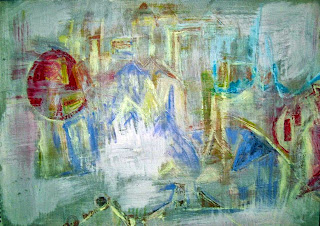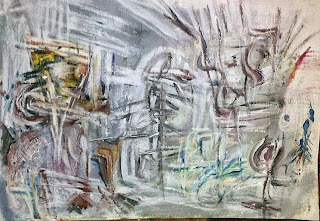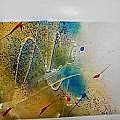Tuesday 24 February 2015
a few words on my work
a few words on my own work..
lost in and drifting unrestricted in, with and as time and space, while at the same time being totally
concrete, realistic and human, all too human...
These images echo the great modern tradition that pictures or depicts motion, energy and flux.
“Energy and motion made visible – memories arrested in space,” as Jackson Pollock said…
My paintings .. they bring out one of the most startling things about visual art:
the sense it is still in motion even when it has stopped;
the feel of paint being liquid long after it has dried.
It is as if art, religion/spirituality and all belief systems, philosophy and science –
all human, socio-cultural practices and emotions, life, death, suffering, bliss, happiness and joy, come together
in all these attempts to suspend moments of energy … the splashy, fluid, stilled moments they wanted to record..
exploration and dynamic expansion, the actual flux of the act of painting are represented, caught in the eternal moment,
eternity, the universal, the reality of many universes (multiverses) are caught – the original, the initial,
the first moment of Creation (caught in the Creation myth of Genesis),
an endless big bang is caught in and outside time, both in time and space and at the same time transcending them
- the eternal now moment of the mystics, all creatives, composers, artists, scientists,philosophers, where beauty or the ideal of
beauty and truth are one, merely two sides of the same coin (viewed in terms of aesthetics or in terms of truth), although being
absolutely concrete, in a certain place, a specific time and space, but going beyond all restrictions of time and space that
human notions, concepts and ideas are limited by and imposed on all our perceptions, attitudes, behaviour and emotions, and in this
sense transcends time and space, motion and energy are caught, while allowed to remain free and at the same time
arrested and made visible.
This is, sums up and represents my mind set, my frame of reference, my unlimited spirit, my life worlds, multiverses (or multi-
dimensional universes), realities, my consciousness, the manner in which my mind and being function and exists and my life,
both in this life and world and in the 'next' or all lives and worlds. I am my art, my art is me, I conceive her, give birth
to her and educate her, often in an unfriendly, hostile, violent, one-dimensional, materialistic world.
why people have set expectations of artists and art
nice, surprising, shocking pictures, recognizable forms and famous names = art?
or -
why people have set, restricted expectations of art and artists, visual art
and the genre of painting.,
Nice, surprising, shocking pictures, recognizable forms, well known names and
famous artists make art - this statement includes most people's notion of Art,
or at least express a) what they expect of 'art', and b) what they 'like'.
What do people want from Art, what do they expect are to be (like), what do they
expect art to do (for them) and why do they,continue, to be interested in and
view visual art?
How many viewers and 'amateurs' (lovers) of art and artists have any idea about
these and other implicit assumptions they make and have about art? What to say,
how many people and artists conceptualize and are clear about about these things?
What are the factors that are involved when someone views a familiar work of art,
the work of a painter that is familiar to them, a new work of art by such an artist
and work by an artist they come across for the first time? Are similar expectations
in play as when someone listens to a composer whose work they know? When they hear
an unfamiliar p[ice by such a composer? When they hear the work of a composer they
are not familiar with? One often hears some popular singer when talking about a
new album saying this: my fans have set expectations of my singing and sometimes
some of them do not like it when I attempt new explorations, new styles and other
forms of music. Are similar sets of expectations involved in the case of the
questions I wrote here about familiar and unfamiliar artists, familiar and
unfamiliar art work?
One could suggest that just as some people are more open minded and flexible in
their everyday lives and probably have more complex, subtle and larger mind sets
than others, in this way some people will have more subtle, larger and complex
frames of reference and understanding when it comes to the arts, art, visual
arts in particular and the painting genre of visual art.
Why is it that many people like paintings that include representations of or
hints to representations of and references to familiar objects such as people,
especially bodies and faces of people, houses, animals, fauna, flora, etc?
Does the inclusion of such familiar objects in a painting make viewers feel
more comfortable? If this is the case then people do not wish to leave or be
compelled to leave their comfort zone, the comfort zone of their everyday
mind set and the frame of reference they employ (or are, what their beings
are like) and they do not appreciate it when their ways of perception
(of perceiving, interacting and dealing with things, external and internal)
are challenged. Most people prefer that their mind sets, frame of reference
and understanding and scheme (system or structures) of perception and
experience are confirmed rather than being challenged.
These are some of the reasons why new works of art, new artists, new styles
and genres in visual art are, initially rejected. The same goes for other
art forms, eg music, performance art, etc. On the other hand, producing
'works of art' merely to shock, catch the attention of or unsettle people
(for example some of the work of Madonna, even her name referring to the
'mother of God", her welcoming of guests at the Tate or some other gallery
by calling them 'motherfuckers",titles such as 'piss Christ', nudity, etc)
or their mind sets, frames of reference, attitudes and values, are no
guarantee that such things have any lasting and aesthetic value. Works of
art may or may not cause such reactions, but such things are not the only
or major raison d'etre or goal and purpose of a work of art.
So what is the reasons for creating works of art? What are the goals and the
purpose for creating such things and behind such actions? Why do some
people find it necessary to create something that did not previously exist?
What is the nature of, the reason for and the meaning of the process of
creation, of creating something, anything, and more specifically for the
creation of phenomena that constitute the visual arts and more specifically
the painting genre of the visual arts?
There are many reasons involved, for example to please a patron, financial
reasons, a diversity of socio-cultural ones, psychological ones, etc. To
explore these reasons one need to involve history of art and of ideas,
socio-cultural and psychological and other factors that are involved in
the production of art, visual arts and the visual art genre of painting.
Such explorations might well reveal psychological patterns and types,
social and cultural factors (for example non-conformists, outsiders,
misfits, etc) that are visible among visual artists, especially painters.
When studying such psychological patterns, ways of social interaction,
types of roles employed to fit into society and produce and maintain
realities or life worlds, one would have to develop a typology of artists.
One typology could divide artists according to the degree in which they
form part of the academic art (teaching and learning) of the day, the
degree in which they or their work, form part of the aesthetic status quo,
or the degree in which they differ from this status quo. Truly original
(viewed in terms of technique, formal structures such as form, colour,
composition, texture, media being employed, one or a few set, limited
styles, or the constant production, changing of, developing, transformation
and transcending of many styles) artists (as the one pole of a continuum
of inventiveness or creativity) will most likely be seen to be more
adventurous, explorative and endlessly changing than those on the opposite
pole of the continuum, namely academic art, Sunday and tourist painters,
etc (paint by numbers according to established, institutionalized
attitudes, norms, leading aesthetic ideals, employing contemporary
fashionable crazes and genres in the visual arts for example digital
art, installations, the artist - his body, bodily fluids, actions,
clothes, furniture, letters, photos - as art, etc. An illustration
from popular music, think of the international craze of 'rap').
One must explore original and academic art and artists in the context
of their own time, for example the different types of Modern (Pre
WWII) and Contemporary (Post WWII) visual art and painting. The latter
in turn should be divided into different periods, for example the early
and later American Abstract Expressionists, Pop Art, and the many
developments in painting since those periods. To summarize, an artist
should be viewed in the context of his time and the specific periods
in which he begins to create and develop. This is merely the 'external'
socio-cultural context in which he works. Then one should explore the
entire body of work of the artist so as to identify its 'internal'
development and transformation. The latter is almost a comparison of
the artist, or his work, with itself. It is possible to divide the work
of some artists in distinct periods, while in the case of others one
finds that there are no distinct periods but that the artist works in
series. A series could be self-contained or develop from one or several
series and be transformed into one or several series. A series could
explore, investigate and analyse one, several or many things, for
example colour, form, media, technique, composition, the degree of
'being off', unity or disunity, etc of a work.
It will seen that the most original or 'creative' artists: work in
series, and that their body of work consist of constant and large
transformations, that they explore, reflect on, question, modify
and develop things such as aesthetic notions, ideals, and other
aspects of the visual genre of painting to a much greater extent
than less original and less creative artists (for example those
situated closer on the continuum of original and academic artists
to the academic pole).
A clarification - such reflection, exploration, investigation,
analysis or "thinking", occurs mostly (not totally) on a pre-
conceptual level or in the sub-conscious of the artist. Obviously
the artist himself or others could eventually conceptualize
these things, but when in the process of creating the artist's
assessments, judgements, 'thinking', etc are pre-conceptual
and sub-conscious, rather than totally rational and explicit.
The 'intelligence' being employed could be referred to as
aesthetic intelligence, in the same manner as one could refer
to the informed skills (or intelligence) of a sportsman, such
as a footballer, an athlete, a swimmer, etc.
It is one thing to evaluate an artist or artists in terms of
their degree of originality, but to assess their skills of
draftmanship, execution of painting techniques, grasp of
perspective, form, colours, composition, etc are totally
different matters.
24/2/2015 ulrich
Monday 23 February 2015
ART, Visual Art/s and Painting
ART, Visual Art/s and Painting
A dictionary will give a number of meanings for the word ART, for example:
a) paintings, drawings, etc
b)the activity of painting, etc,
c) paintings, drawing , etc as subjects of study,
d) arts, subjects of study that are not scientific subjects,
e) the arts, activities such as music, art, film, theatre and dance considered together,
f) an activity that needs special skil or knowledge.
Visual Arts, according to one dictionary, are types of art in which you make something for
people to look at, for example painting, drawing and photography - compare performing
arts.
Painting, according to one dictionary, is
a) a picture made using paint,
b) the activity of using paint to create a picture,
c) the activity of using paint to cover something.
It is possible to quibble about the above, to provide other meanings of these words,
to produce examples of other phenomena and activities not included in the above.
One finds numerous examples of such thinghs in developments in Art, Visual Art/s
and painting in the last and present century.
The points I wish to explore here concern other issues and aspects of Art, the
Visual Arts and Painting. I wish to ask questions concerning the social, the
sociological, the psychological, the cultural and socio-cultural functions,
factors, aspects, purposes, values, uses, meanings, etc of these three
things.
Let each of us ask ourselves -
what do I understand by Art?
by Visual Art?
by painting?
Would my responses be different depending on when (what age) I am asked these
questions?
Would the responses of more educated and less educated people differ?
Would the responses of those who work in the arts and sciences, commerce,
crafts, skills (skill such as carpentry, mechanics, engineering, etc),
sports, etc different?
Would the responses differ according to age groups, to the ethnicity,
the culture, the country (of origin, upbringing) and the historical period
in which individuals live?
These questions should give us the insight that there is no one, absolute
thing that is referred to by the words - Art, Visual Art and Painting.
However, this is merely touching the surface, considering these things
in general and from the outside in some kind of timeless, universal
context, perspective and point of view. I wish to make these questions
more personal by involving the values (in general and aesthetic ones
in particular), the attitudes, the feelings, emotions, perceptions,
mind sets, frames of reference and of understanding, interpretations,
assumptions. suppositions, pre-suppositions, etc of every individual.
What do I expect from Art, from Visual Arts and from Painting?
What do I consider to be good, average or bad Art, Visual Art,
Paintings?
What are the norms and standards I employ to make these judgments?
What are the things I employ to make sense, interpret, respond to,
encounter, react to paintings in general or a specific painting?
Am I aware of these rules and norms I employ? Are these norms
objective, intersubjective, universal, personal, emotional?
Where did I obtain them? Did I develop them myself, obtain them from
professionals, by education, relatives?
Do I consider the medium being used, the techniques, the process of
painting, the structures (such as form, colours, composition, textures,
etc), my emotional reaction to a painting?
What do I want from, seek from and expect art and a painting to do,
to be, to present or represent?
Does it make a difference to my perception and judgement if I know
the name of the painter? If the painter is unknown or a famous and
established artist? Why are different prices placed on the work of
different paintings? Are the paintings themselves being considered
or the name of the artist, the price paid for his work, his fame, etc?
Does the size of a work of art matters ? Do large paintings that I enter
and become part of or small works that I treat as if they are objects,
like a chair or table, I look AT make a difference how I react to
and interpret a painting?
a few words on my own work
a few words on my own work..
These images echo the great modern tradition that pictures motion, energy and flux. “Energy and motion made visible – memories arrested in space,” as Jackson Pollock said…
my paintings .. they bring out one of the most startling things about his art: the sense it is still in motion even when it has stopped; the feel of paint being liquid long after it has dried.
It is as if art, religion/spirituality and all belief systes, philosophy and science – all human, socio-cultural practices come together in all these attempts to suspend moments of energy
… the splashy, fluid, stilled moments they wanted to record.. exploration and dynamic expansion, the actual flux of the act of painting are represented, caught in the eternal moment,
eternity, the universal, the reality of many universes (multiverses) are caught – the endless big bang is caught in and outside time, both in time and space and at the same time transcending them - the eternal now moment of the mystics, all creatives, commposers, artists, scientists, philosopjhers .
transcending time and space ,,…. motion and energy are caught, arrested and made visible
Sunday 22 February 2015
Subscribe to:
Posts (Atom)



































